Tyre protection is just the tip of the iceberg
Editor's note:
In the 1970s, a small table tennis led to the development of the Sino-U.S. relationship. It became an international talk; 40 years later, the Sino-U.S. tyre protection case has become a hindrance to the economic development of the United States and China. "big ball;.
When China’s tire associations and companies wrote a letter to Premier Wen Jiabao, when we “speak; President Barack Obama, the government has become a life-saving straw that we have high hopes, but only rely on this “straw; can make trapped tire industry Going ashore?
Adventure game
When companies place all their hopes for the U.S. safeguard case on the government, more risks are coming.
The highly concerned and determined position of the Chinese Ministry of Commerce and the statement made by Coopertire, the second largest tire company in the United States, seem to have brought a new turn for the US tire special protection case, but it is slowly cheering.
On June 18, 2009, the Brazilian Foreign Trade Commission decided to impose anti-dumping duties on the tires of passenger cars and trucks imported from China. Because of the low export volume, the tire market is placid, and this is not the case.
On June 29, 2009, the United States International Trade Commission (ITC) proposed to take special safeguard measures against Chinese tires. Since January 2009, natural rubber prices have risen by more than 50%. The price of tire products has been falling. If this trend continues, the profits of tire companies in the first half of the year will be exhausted.
Under the financial crisis, “there are no three guarantees; tires run rampant, set off price wars, and good and bad products are mixed, giving up brand and quality for survival.
......
A series of phenomena indicate that China's tire industry is already suffering from internal and external problems, external squeezes, and internal melee, and it is urgent for the country to throw out heavy punches, regulate, and rectify. It is imperative for companies with a sense of mission to rise and set an industry benchmark.
Special protection case is just the tip of the iceberg
According to reports by the Brazilian media on June 19, the Brazilian Foreign Trade Commission decided on the 18th to impose anti-dumping duties on passenger cars and truck tires imported from China. In the future, it may impose anti-dumping duties on light-duty tires imported from China.
In the past six months, Brazil has imposed a “temporary; anti-dumping tax on US$1.33 per kilogram of passenger and truck tires manufactured in China with specifications of 20, 22, and 22.5 inches. The decision made on the 18th will Anti-dumping duties are formalized, effective from June 18, 2009 and valid for 5 years.
According to Chinese manufacturing companies, the anti-dumping tax is divided into three levels of $1.12, $1.42, and $2.59 per kilogram. On June 29th, 2009, the United States International Trade Commission (ITC) proposed that Chinese tires for passenger cars and light trucks be increased by 55%, 45% and 35% respectively for 3 consecutive years on the ground of Chinese tires disrupting the US market. Special tariffs triggered the first case of Sino-US trade friction in the Obama era; US President Barack Obama will make a final ruling on whether to implement sanctions measures before September 17.
Not to mention that China’s tire sales to the United States made up for vacancies caused by American tire manufacturers’ entry into the high-end products market, and it did not say that the special security case would affect the interests of many U.S. dealers and raw material producers, resulting in about 25,000 U.S. jobs being unemployed. It will also compel US domestic consumers to spend more money to buy alternative products. It will be scary to criticize this “because of the bad behavior of others; it only looks at the impact on the Chinese tire industry.â€
It is understood that about 40% of tires produced in China in the past two years are exported, and one-third of them are exported to the U.S. market. Once the special security case is implemented, Chinese tires lost to the US will lose nearly half to US$1.1 billion. It will affect the employment of about 100,000 workers; not only that, once the Obama administration's ruling comes into effect, the special security crisis may also spread to other industrial chains and once again make “Made in China; it is in a trading plight.†Fan Rende, president of the China Rubber Industry Association, said that Will be placed in the United States export tires to the company!
What should companies do?
Yan Liangguang, general manager of Qingdao Double Star Tire Industry Co., Ltd., said in an interview with this reporter: “We have a lot of tires exported to the United States. If it is really implemented, it will certainly cause great losses to us. But this problem is not a business In solving the problem, we can only look forward to national policies.
Shandong Linglong Group's situation is fairly good. The family who chose the tire business for generations when choosing a US dealership now has an effect. Due to its solid foundation and relatively high capacity, many dealers have said: “We will If we persist, even if it is a 55% tariff, we will try to digest it.
Delphi Group President Wang Feng told reporters: “The dealers have stepped up promotional efforts to enhance the brand, the company side will cooperate with increased R & D investment, upgrade products. In the United States, high-end tires of our national brands and foreign brands price difference of 200 % ~ 300%, while the low-end tires only 30% to 50%, after the increase of tariffs, only to the high-end development will have a way out.
The U.S. "special protection case is very important for the country from top to bottom. Under the hardline attitude of the Chinese government, Obama will weigh up on whether he can sign or not. This is an accident, and what is more serious is the internals of the industry. situation.
Congenital problems to be solved
China's tire industry has been driven by the automobile industry and supported by national policies in recent years, showing the prosperity of the industry and a hundred schools of thought. The tire radialization rate has grown from 20% during the Ninth Five-Year period to 75% today. It has become the world's major tire producer and consumer country. Tire export has once appeared “blowout; growth; it has surpassed Japan as the US market since 2007. In the second-largest tire importer on the Chinese market, the tire industry in China is "unbelievable to the West because of its rapid development and low product cost."
However, it is not difficult to find that the prosperity of the Chinese tire industry is actually a kind of “bubble economyâ€, which has contributed to the growth of the industry in a specific historical environment. This has led to the development of the industry and left behind serious complications. It is a small scale and weak brand. Poor technology.
China's tire industry entry threshold is too low and lacks necessary industry development planning and supervision. It is often a small tire company that employs an engineer, buys a design drawing, a loan, and a piece of land. Even in 2008, when the tire market was seriously oversupplied and the economic crisis had erupted, many regions still launched tire projects.
A typical case is that a tire and rubber distributor in Shandong Province, which operated tire sales for several decades, has annual sales of more than 2 billion yuan. Last year it suddenly decided to switch to tire production. It immediately purchased equipment and digged several other tire factories. Technical personnel, tire manufacturers have done so, as of the press release, the company has begun to produce finished products, but the pass rate is less than 80%.
The reporter drove to Dongying, Shandong, where he saw a dozen tire factories of various sizes, and several areas near Dawang Town. There were about 40 tire factories. Jinyu was one of the largest, with annual sales of only 20 billion yuan. While some small tire companies look more like home workshops, simple rooms produce tires that are related to the driver’s fate.
During the period of the Ninth Five-Year Plan period, tire investment across the country was booming, springing up more than 500 manufacturing companies, and in Shandong alone, there were about 200 tire companies. Among these national brands, annual sales exceeded 10 billion yuan. Only three tire companies, including Linglong of Shandong and Hangzhou Zhongce, have less than 30% annual output of more than 3 million sets. So far, the average annual output of tire companies in the country is only 1 million sets.
According to the reporter's understanding, the world's three largest tire giants Bridgestone, Michelin and Goodyear occupy more than 60% of the market share, while China's tires more than 500 companies have only a 10% share. In the global tire industry rankings, no Chinese company has reached the top ten so far. With a small scale, it is difficult to invest in R&D, branding, and management. Weak branding and poor technology are inevitable.
An industry insider said: China's tire exports have "amount of quality; the drawbacks, the product structure is mainly concentrated in the low-end, often by virtue of cheap labor costs to go the marginalization of the line, envy others" food Tasteless tasteless; some products are simply not profitable, and they are only pegged to the country's export tax rebates. Either it is an OEM for international brands and earns poor processing fees. The tire industry in developed countries mainly produces high-end products, and the profits are considerable. What they export to China are products that are several times or even several times higher than the profits of low-end products. Due to the lack of gaps in core technologies and product grades, behind the export volume of China's tire companies, it is “failure to earn money; helplessness; helplessness. Many tire companies in China are OEMs for foreign tire giants, which is enough to show that these companies have high-end production. The level of equipment and management capabilities of tire products, there are many products in terms of quality, performance and international brands are not much difference, but there is a wide gap in prices, the reason is that there is no brand of international influence.
Foreign brands build factories in China and use domestic cheap labor to produce lower-cost products. At the same time, the products are put on the domestic market at a high price, and they are collected and profit-collected and returned to foreign-funded enterprises. This kind of "empty pockets to install meters; trade patterns also reflect the weakness of national brands.
[next]
Vicious competition for survival
In the case of a good market situation, small tire companies can survive, but once the environment deteriorates, bankruptcy is inevitable. Tire production has a large investment, complicated technology, and a large amount of working capital. Most of the company's project construction depends on bank loans. Under the financial crisis, these companies had to kill chickens and take eggs to repay bank debts, which also triggered a series of "suicide-type unfair competition." .
The homogenization of the domestic tire industry is serious, and the product structure is relatively concentrated. It is difficult to compete with the country and the brand in the high-end product series. Therefore, companies hold hot products with low-end products among national brands. As a result, all-steel cutting tires, three-pack tires, and buyout service tires have appeared on the market, and even the market share in individual markets is almost equal to 50%! No quality, no brand, no service, at all costs Reduce costs, put aside the safety of users without any guarantee, and seek for survival.
According to statistics, on the highway, 60% of traffic accidents are related to tires. Under the financial crisis, accident reporters who did not “three bags of tires†were unable to investigate, but it is certain that this is absolutely chilling data.
"From last year to March this year, I often received phone calls from dealers and regional managers. I asked if the company can produce three bags of tires, because several large companies have already joined this vicious competition. The exquisite market was severely impacted, and dealers could not stand still.Forcing companies to constantly make policy adjustments, to support the dealers, and to reduce the profits of the enterprises to zero or even to lose money, it was hard to resist the days, but for the drivers The personal safety and exquisite brand, worth it, Wang Feng was unbearable.
Yan Liangguang said: "The industry has been conducting disorderly competition, which has seriously damaged the normal development of the enterprise. Under persecution, we can only do so. It seems that companies do not want to have a good competitive order. They are willing to compete fairly, but often they are counterproductive and forced to participate, creating a vicious circle.
Mr. Zhou, a truck owner, told reporters: “When the financial crisis hit, the logistics industry was greatly affected. My transportation business was also very poor, and a car with a few wheels of 10 should be replaced twice a year on average. This is not. Small expenses, so choose not three bags of tires, cheaper, can save a little is a bit, although it is scared at the time of opening, but there are still chances.This is the buyer's mentality.
The dealer, who declined to be named, said: "We don't sell three packs of tires to make less, but there are three packs of tires, and normal tires are difficult to sell. This is no way.
Rubber prices rose
Zhao Lixin, general manager of Qingdao Yakai Rubber Co., Ltd., briefed the reporter: “The main type of imported rubber is No. 20 rubber. From January 2009 to the end of July 2009, the price rose from 1 ton of about 1100 US dollars to 1 ton of about 2000 US dollars. The price of the main rubber type No. 5 has risen from approximately RMB 10,000 to RMB 17,000 per ton. This is the spot price and the futures are more expensive. It can be said that the increase rate is very large.
Song Jie is the head of the procurement department of Henan Fengshen Tire Co., Ltd. He told reporters: “Natural rubber is the main raw material for tire production, which can account for about 50% of the cost of tires. The sharp rise in rubber prices is similar to the crazy growth in 2007. Certainly, Seriously affecting our profits, the daily nerves of our purchasing department are tight, and the data on futures trading is very heavy every day.
In the financial crisis, the state introduced policies to encourage the development of small-displacement vehicles, which resulted in the blow-out of small-displacement cars. However, as of July, automakers' profits have been negative, so they will also strongly drive down the prices of components. . In the retail market, tire prices have continued to decline due to the impact of three-pack tires and fierce competition in the industry.
Sun Zhenhua, chairman of Huanghai Rubber Co., Ltd., said: "To increase the sales price of products is a method to deal with high costs, but it is not the only way. Optimizing product structure and strengthening innovation ability is the only way for companies to resolve external pressure and find a bigger market space. Only through the implementation of new materials, new formula design, new product development and new structure adjustment, etc., effectively reduce the cost of raw materials, maintain price advantage, thereby enhancing the competitiveness of enterprises and win business opportunities.
Where is the way out?
Faced with this series of internal and external problems, China's own brand of tire companies survive in the cracks, the situation is difficult. These require the joint efforts of countries, industries, and enterprises.
Cai Weimin, secretary general of the China Rubber Industry Association’s tire branch, said in an interview with reporters: “In the case of the special security case, the government and the association will surely win the results we are satisfied with. Our country imports a large number of US soybeans and other agricultural products and holds a large US national debt. This may be our bargaining chip.
"In terms of industry development, I think that we should encourage mergers and reorganizations within the industry, form large enterprise groups, and foster the development of large enterprises. Only by doing so can we be among the top 10 in the world. This is also a development trend, but mergers and acquisitions are Very complicated matters involve various capital formations, corporate interests, and local government interests. It is easy to say that it is difficult to do so, and it needs the country’s strong encouragement policy to promote it.
“The rise in raw material prices is the trend this year. Domestic tire companies should work hard to grasp the pricing power of raw materials pricing. The government should encourage companies to go out and buy rubber plants and build rubber processing plants. Our country relies heavily on raw material imports, which is a great risk. of.
What does a tire company need?
Yan Liangguang said: "The low threshold of the industry and the lack of competition require full play of the role of industry associations.
Wang Feng said: "Strengthening and expanding are the wishes of every company, but unfair competition has seriously damaged the order of the industry. We hope that the state will formulate industry access systems, improve quality standards, strictly enforce the law, and strictly handle illegal competition. The state should encourage enterprises to innovate and have competent enterprises to set up factories overseas in order to avoid increasingly serious foreign anti-dumping measures.
ChangLong winding Stretch Film Machine is a kind of packaging machinery with electrical equipment, using LLDPE, PE, PP, CPE and so on material as raw material to manufacture the single/double-side self-sticky single-layer, double-layer, three-layer or five-layer co-extrusion stretch wrapping film with film width from 500mm to 2000mm, which utilizes the film`s good winding tension, anti-pricking ability, and impact strength to pack various bulk objects or self-contained objects as a whole packaging. This stretch wrapping film machine can also manufacture protective film, PE preservative film, embossing film, silage film and other films by changing some machine parts like T-die or assistant machine.
*Related Products:stretching Cling Film Machine,film wrapping machinery,film stretch production line.
Machine Pictures:

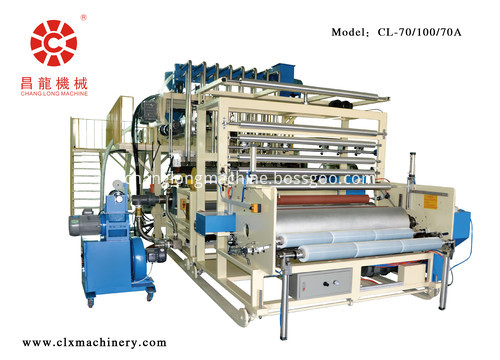
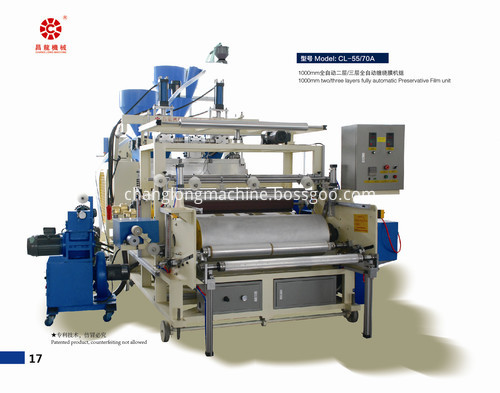
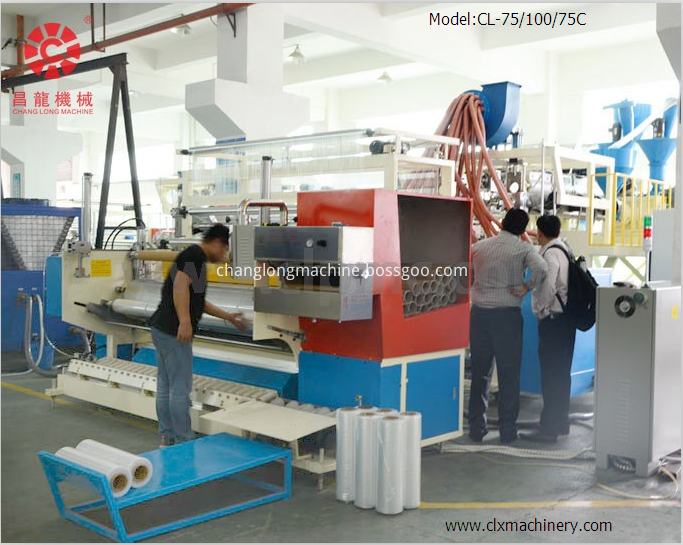
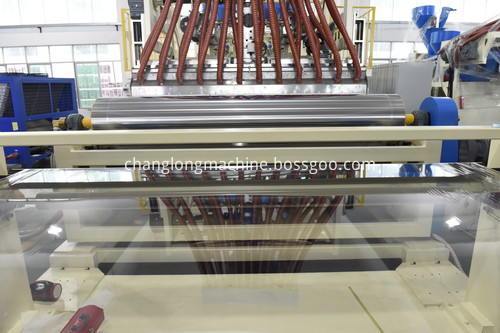
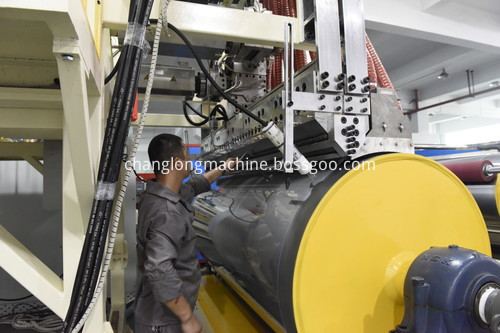
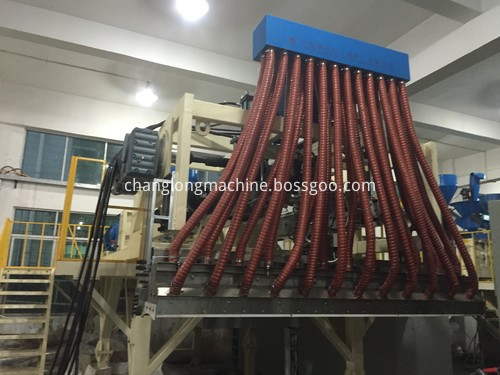
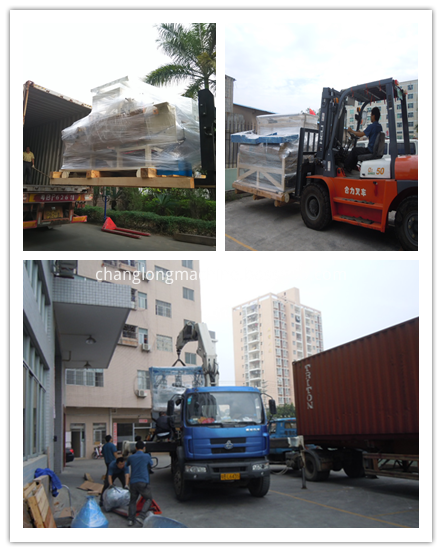
Various Films:
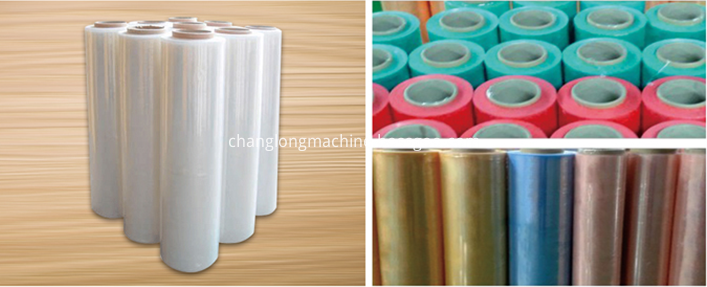
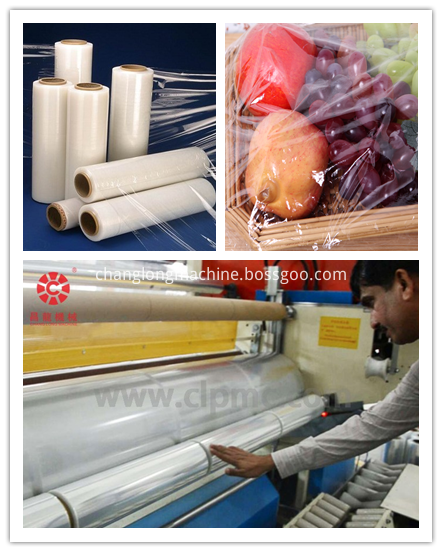
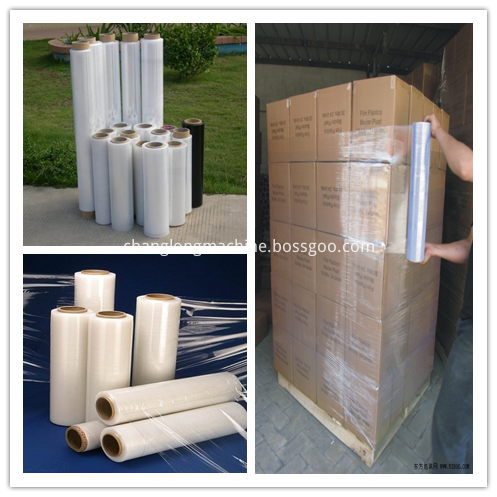
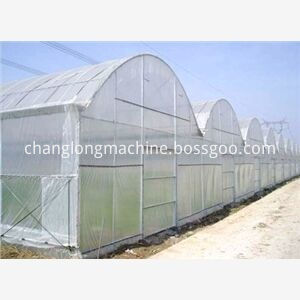

Stretch Film Machine
Hand grade stretch film machine,Machine Grade stretch film machine,Jumbo roll stretch film machine ,Pre stretch film machine
CHANGLONGXING SCIENCE & TECHNOLOGY (SHENZHEN) CO.,LTD , https://www.clxmachinery.com
